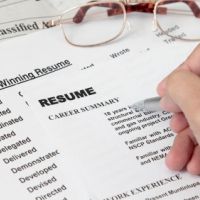When writing the first draft of your résumé, you probably know it could be -- and should be -- stronger than it is. If you're like many job seekers, though, you might feel pretty mystified as to which specific steps will lead you to more powerful content and a more attractive design.
Fortunately, boosting a bland résumé or simply polishing it before applying for a job isn't as cumbersome as you might expect. According to Evelyn Salvador, author of "Step-by-Step Résumés," there are many simple, yet effective, tricks that can significantly strengthen your résumé's readability, call to action, marketability and overall appearance.
In her book, Salvador recommends you take the following steps to improve a résumé before using it to apply for jobs:
1. Remove personal pronouns. The subject (I, me or my) is understood in your résumé and you should leave it out of each sentence. If your résumé contains any of these words, delete them and restructure your sentences if necessary.
2. Check for action verbs. Be sure each bullet in your "professional experience" section starts with an action verb or adverb preceding the action verb.
3. Delete redundant or superfluous words. Review each sentence or bullet and delete any words that your sentence reads fine without, such as "the" and "that," as well as unnecessary "fluff" words. Edit down to the most concise sentence possible without omitting any important content, such as achievements.
4. Include personal attributes. Double-check that your primary attributes are included in your "professional summary" section and that you didn't leave out any important ones.
5. Ensure that all pertinent, targeted qualifications are included. Compare your résumé to the description of the job you're targeting. Is there any information you didn't already mention that would address a function or need listed in the description? If so, revise your résumé to include that information.
6. Prioritize your bullets. Review your responsibilities and achievements in each position and move the more important, targeted ones closer to the top under each position.
7. Remove irrelevant information. Check to ensure that anything irrelevant or not directly related to your targeted goal is minimized, put toward the end or omitted altogether so that your résumé includes more relevant information.
8. Subdivide and categorize bullets. If you have many responsibility and achievement bullets under each position (say, more than 10), you can divide them into two categories ("responsibilities" and "achievements") and subtitle them as such under each position for easier reading.
9. Check for quantifying information. When reviewing your sentences, ask yourself, "Did I include how many, how much, how often, how big, how fast, how well and so on?" If not, go edit your sentences to include more specific, concrete information.
10. Verify that "CAR" and benefit info is included. Do your achievements include the Challenge you faced, the Action you took and the Result? Be sure you show how well you performed these functions and always include the benefit(s) to the company.
11. Vary bullet line length. Try for a good mix of line lengths. Bullets are effective when they are a combination of one, two and three typed lines. Because it is important to show not only what you did, but also how well you did it and what the benefits were to the company, information should be concise without sacrificing content or meaning. In this way, you will have an action-packed, achievement-oriented résumé that is tightly and concisely written.
12. Check grammar, punctuation and spelling. Spell-check your document in your word-processing program. Proofread several times. Be consistent in your use of capitalization and hyphenation. Be sure you have used correct grammar and punctuation. If this is not one of your fortes (and it isn't for many people), give your completed résumé to someone you trust to proofread it for you.
13. Add more descriptive adjectives or adverbs where applicable. Check to see whether you can infuse any additional descriptors that show how well you performed your job functions.
Selena Dehne is a career writer for JIST Publishing who shares the latest occupational, career and job search information available with job seekers and career changers. She is also the author of JIST's Job Search and Career Blog (http://jistjobsearchandcareer.blogspot.com/). Follow her on Twitter at http://twitter.com/SelenaDehne.
Advertisement
You have just read the article News for today's that category by title A Résumé Checklist: 13 Things to Do Before You Apply for the Job. You can bookmark this page with a URL http://news-these-days.blogspot.com/2011/03/a-resume-checklist-13-things-to-do.html. Thank you!
Posted by: Anonymous
A Résumé Checklist: 13 Things to Do Before You Apply for the Job Updated at :
6:07 PM
Saturday, March 12, 2011


Post a Comment